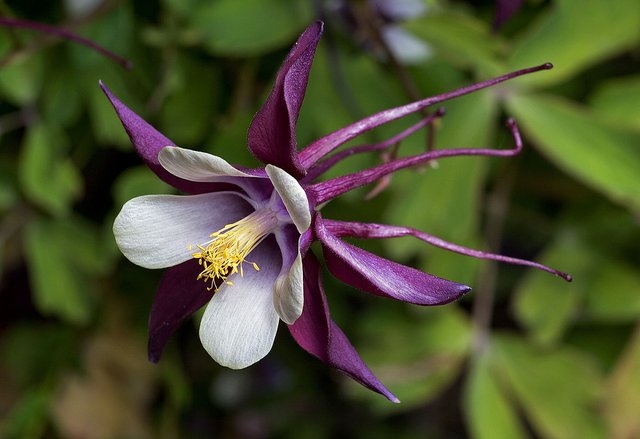Aquilegias are unbelievable.
Aquilegias are also known as Columbines or Granny's Bonnets. They are a hardy perennial plant suitable for Temperate to cooler climates. They can be grown in warmer areas but they may suffer from Mildew, a fungal disease caused by humidity. These plants are one of my favourites, growing naturally in Meadows of the Northern Hemishphere. I love the shape of the flowers and the amazing colours. Here in Sydney, they are just starting to grow after the dormant winter period. Mine have only just started to grow their first leaves. There are quite a few varieties, ranging from taller plants around 60 cm to smaller ones around 20 cm high. Plant them in a semi-shaded sheltered spot, under some trees or in pots. I have seen some great plants in Sydney, but since they are not flowering here, i had to borrow this image from a grower's website.

Source ; https://www.tesselaar.net.au/product/4913-aquilegia-songbirds-collection
One of the sweetest flowers in spring gardens is the Columbine. Columbine plants (Aquilegia) have an airy appearance, with small, rounded leaves and tall flower stalks that hold the blooms above the foliage.
Source
Aquilegia's bell-shaped flowers are popular with hummingbirds, bees, and gardeners. The mid-spring blooms fill the void between early spring bulbs and peak garden season.
Source
Source
Columbine flowers are associated with woodland gardens, but most are widely adaptable. Most varieties of Columbine plants will bloom for at least four weeks. They are tougher plants than they appear, but they tend to be short-lived perennials.
Source
Source
However, they will seed and spread, remaining in your garden for years.
Text Source
Fav. comment Award ! You chose great pics and information on Aquilegias. Well done .
Thank you 🙏!
Sometimes known as columbines or granny’s bonnets, aquilegias are charming, old-fashioned cottage garden plants with bonnet-shaped flowers, often two-tone and with long graceful spurs. They come in a very wide range of colours, from white to pale pink and from dark purple to red.
Flowering in early summer, aquilegias fill the seasonal gap between the last of the spring bulbs and the first of the summer flowers. They self-seed readily, and look wonderful naturalised amongst shrubs and roses. However, the plants interbreed freely and seedlings rarely resemble the parents. If you’d rather avoid this, deadhead plants after flowering to prevent self-seeding.
Grow aquilegias from seed, or buy them as plants at the garden centre. Grow in fertile, moist but well-drained soil in sun to partial shade, in the middle of the border.
Lift and divide clumps every three to five years and mulch annually with well-rotted manure or compost.
https://www.gardenersworld.com/plants/10-aquilegias/
Congrats, you won the Fav. comment Award shared with another Steemian. Great choice of pics showing leaves and flowers.
That is a amazing flowers and really beautiful . the beat of garden.
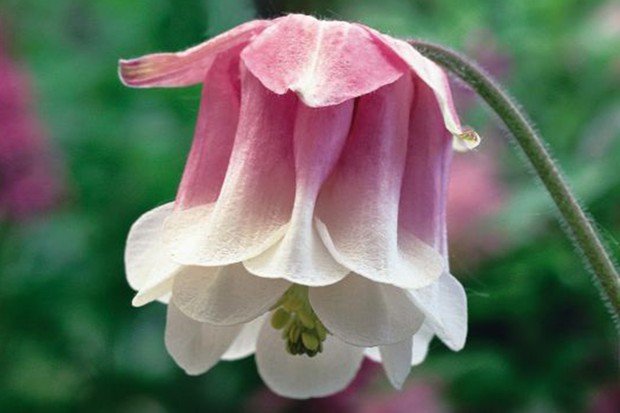
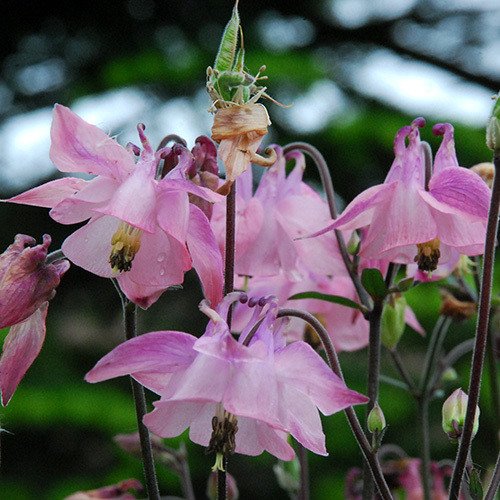
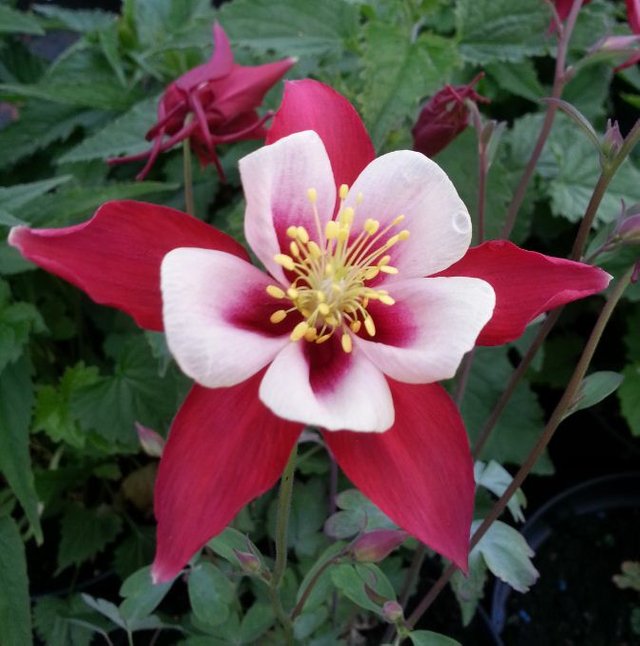
Thanks for the information.
https://encrypted-tbn0.gstatic.com/images?q=tbn:ANd9GcQUp1ARKZukRYSCBA51ZD7qifHIoK4MrHwjpChdnr4KOjXiw70q
100% like and resteem
Silly Sausage Award ! Great choice of Pics for this plant.
Aquilegia Vulgaris Picture: Andrew Crowley
Only a few Far Eastern aquilegias are in general cultivation. A. viridiflora is a small, dainty plant, with numerous nodding flowers of chocolate-brown and mossy green. It is best grown in an elevated position, such as a raised bed, where its delicious perfume and subtle demeanour can be enjoyed at close quarters.
In Japan, A. flabellata and its numerous hybrids have long been cultivated, although the species is unknown in the wild. Hybrids like A. flabellata 'Ministar' and A. flabellata 'Nana Alba' are consistently popular among alpine enthusiasts. Its small, stocky plants are loaded with flowers, making up for its lack of grace.
Growing tips
Aquilegias lend themselves to cottagey or semi-wild settings. Most relish dappled shade. They love deep, rich soil. Most garden varieties do not resent clay, but alpine types prefer well-drained loam. When planting, work in extra humus: old muck or garden compost is best. Mulch with the same material.
Remove seed heads before they disperse their contents, otherwise the parent plant may be crowded out by its own offspring. Save the seed and sow it fresh if you want more plants elsewhere.
Good companions
Try A. longissima contrasted against the darkly dramatic foliage of Cimicifuga simplex var. simplex Atropurpurea Group or in combination with pale-lemon buttercups and golden grasses. Plant blue A. alpina as it grows in the wild, with Geranium sylvaticum and trollius. A. formosa and A. canadensis, both of which are soft red and yellow, look at home with Primula cockburniana, a small asiatic primula with vermilion flowers.
https://www.telegraph.co.uk/gardening/howtogrow/3299601/How-to-grow-aquilegia.html
wow,really very fantastic flower pics always showing in your blog. you always giving a big refreshment of my mind to giving flower post.i am always attracted them.every photo you pic up very perfectly.so,its always impressible and my heart touching..this is a very attractive flower of aquilegia flower plant.i sm really appreciating to see your post and i support your every work.because its very perfect and original.i am first time seen this types flower...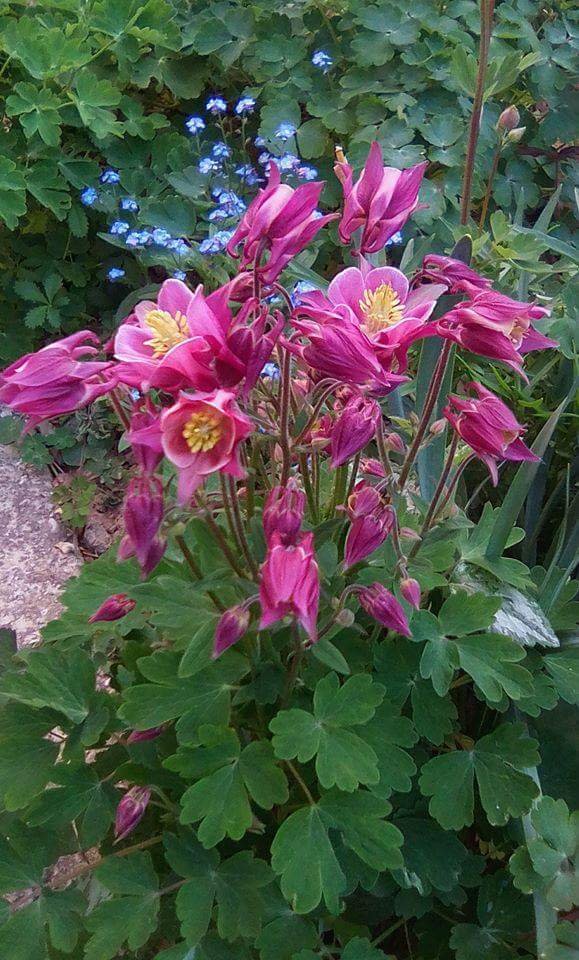 The columbine plant (Aquilegia) is an easy-to-grow perennial that offers seasonal interest throughout much of the year. It blooms in a variety of colors during spring, which emerge from its attractive dark green foliage that turns maroon colored in fall. The bell-shaped flowers are also a favorite to hummingbirds and may be used in cut-flower arrangements as well..
The columbine plant (Aquilegia) is an easy-to-grow perennial that offers seasonal interest throughout much of the year. It blooms in a variety of colors during spring, which emerge from its attractive dark green foliage that turns maroon colored in fall. The bell-shaped flowers are also a favorite to hummingbirds and may be used in cut-flower arrangements as well.. 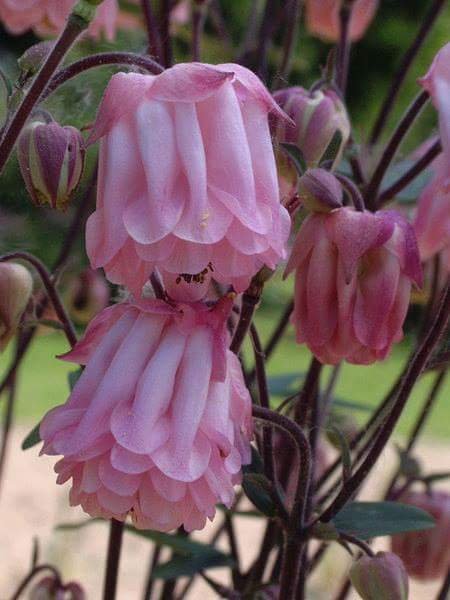 European Columbine (Aquilegia Vulgaris)
European Columbine (Aquilegia Vulgaris)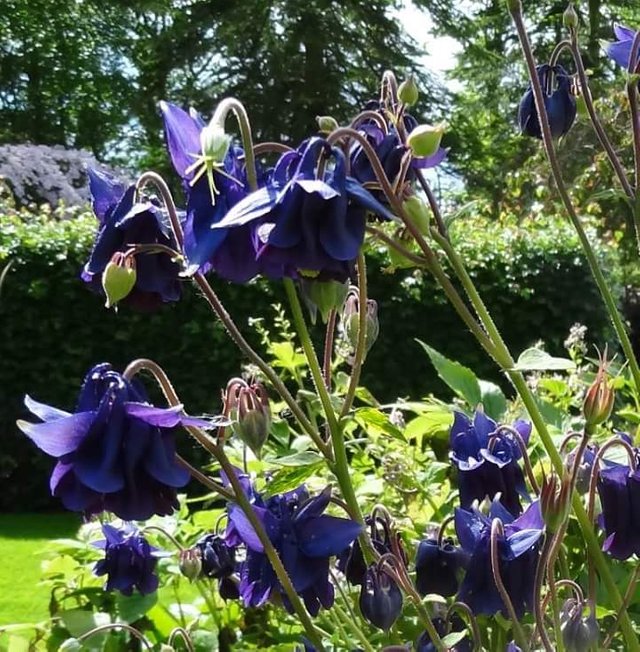 Aquilegia vervaeneana 'Woodside Blue'............
Aquilegia vervaeneana 'Woodside Blue'............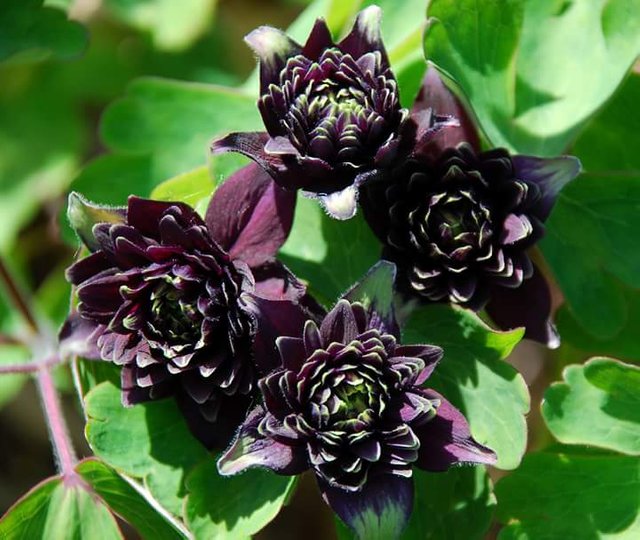 Aquilegias are flowering now. This plant produces bee-pleasing flowers in May, a month when other flowers tend to be in short supply.
Aquilegias are flowering now. This plant produces bee-pleasing flowers in May, a month when other flowers tend to be in short supply.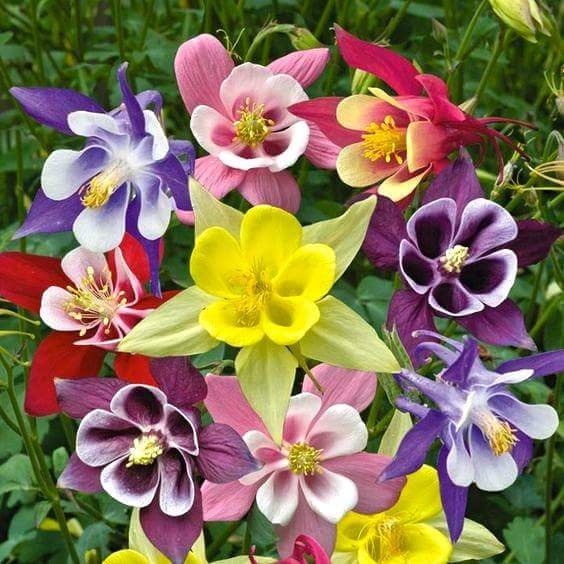 ~ Plants ~
~ Plants ~
This plant has showy flowers that range in color from purple, white, red, and blue. It has a broad long spur stout and is strongly incurved. It attracts humming-birds and bumble-bees.
Perennial – Blooms spring-fall – Zone - Height 10-18” sun to partial shade
OFFERING 50 SEEDS FOR $1.00..
Wonderful Aquilegia with purple blue flowers and great variegated laeves. Even when the plant is nogt flowering, it's still attractive till October...
They are also known also known as Columbines or Granny’s Bonnets and come in many beautiful colours and varieties.
They are extremely easy to grow and self-seed all over the place. You can choose to keep the seedlings and see what comes or just pull them out.
But, left to their habit of promiscuous (!) interbreeding, the flowers will tend to dark blue or red in the end.
We have one posh Aquilegia in the Park, the rest are all cross-breeds. The photo is of the posh one.Aquilegias are flowering now. This plant produces bee-pleasing flowers in May, a month when other flowers tend to be in short supply.
They are also known also known as Columbines or Granny’s Bonnets and come in many beautiful colours and varieties. They are extremely easy to grow and self-seed all over the place.You can choose to keep the seedlings and see what comes or just pull them out.But,left to their habit of promiscuous (!) interbreeding, the flowers will tend to dark blue or red in the end.We have one posh Aquilegia in the Park, the rest are all cross-breeds. The photo is of the posh one.
A columbine is a worthy addition to the witch's garden. Many use this Venus plant in love magic, and it is said to be a favorite of the Fae (it definitely attracts hummingbirds). Europeans have traditionally seen the connection between this plant and birds. The word "columbine" comes from the word for dove--the flower was considered to look like doves in a circle. At the same time, the Latin name, Aquilegia, comes from the word "eagle," as the back of the flower was throught to look like an eagle's talon. There's an interesting juxtaposition between predator and prey going on with this plant (eagle/dove) that is borne out as well in the plant as a whole, as the leaves are very poisonous while the flower of the North American columbines was eaten as a condiment by natives of North America (I wouldn't go testing that out, though). I finally have the wild European columbine seeds in stock again. I also have cultivated European columbine seeds I harvested from my own plants (witch-grown) and the North American wild columbine, a forest beauty.thanks to sharing for your great post with u.. very well done..take care yourself and bezt of luck of your great work.but i am realy bad feel this time.because only one person disturb doing any comment time and telling very wrong word this platform.this person name magoo.i don,t know what,s the oriblem this person.always doing mistake talk every steemians work matter.but any person not take any step this bad person bad work matter.i hope you take step this person bad work and rough talk matter.i hope that you support my work.may god bless you.i want you stayed always live long happily your whole life..my best wishes anytime with you.see you again.. my dear friend.. @ctrl-alt-nwo thank you my best friend have a great day..
Please quote SOURCE for photos, otherwise you just copy others work.
An interesting plant and an interesting story is about it. Aquilegia is also called an orlice or catchment. It belongs to the genus of perennial herbaceous plants of the family of buttercups. According to various sources, this genus combines 60-120 species of diverse plants that grow in the mountain regions of the Northern Hemisphere. Approximately 35 species of this plant are cultivated. Where does the Latin name come from, exactly and is not defined. So, according to one version, the name is formed from words such as aqua - "water" and legere - "collect", and on the other - that this word originated from aquila - "eagle". Such a plant has long been known to flower growers. A reference to it can also be found in fiction. So, in "Hamlet" Ophelia offers Laertes a columbine flower (and this is how England is called aquilegia). And in the Middle Ages, if the artist portrayed the flower of a given plant in the picture, it was indicative of the presence of the Holy Spirit.
https://rastenievod.com/akvilegiya.html
Thank you for the beautiful flowers, I have not met them before ...
Aquilegia, or otherwise - a catchment, is distinguished by a completely unusual form of a flower with a short curved or long straight spur. Flowers are located on tall peduncles, rising above the thick foliage. Aquilegia is a perennial plant, which, nevertheless, regularly (every 3 to 4 years) needs updating landings. However, this is usually not a problem, because the catchments are multiplying well by self-seeding.
Propagation of aquilegia, usually seeds, but also used the division of the bush and cuttings. Share bushes in autumn or early spring. From a large plant, up to five chunks are obtained; each of them must have several developed kidneys. Seeds are sown in the open ground or grown at home seedlings. Most plants give abundant seed.
Planting aquilegia is best placed in the penumbra. They grow in the sun, of course, if they have enough moisture, but such spectacular flowering will not be, and the foliage is shallow. On humus water-permeable, loose soil with sufficient moisture, the plant forms a powerful shrub that is good not only at the time of flowering.
Care of aquilegia consists of watering in arid weather, pruning wilted inflorescences. Tall grades often require support; without it the peduncles in the wind or after the rain break down or lie down on the ground. Thank you @ctrl-alt-nwo
https://7dach.ru/MarinaGerasimenko/izyaschnye-akvilegii---zvezdy-tenistyh-uchastkov-239.html
The genus name Aquilegia is derived from the Latin word for eagle (aquila), because of the shape of the flower petals, which are said to resemble an eagle's claw.
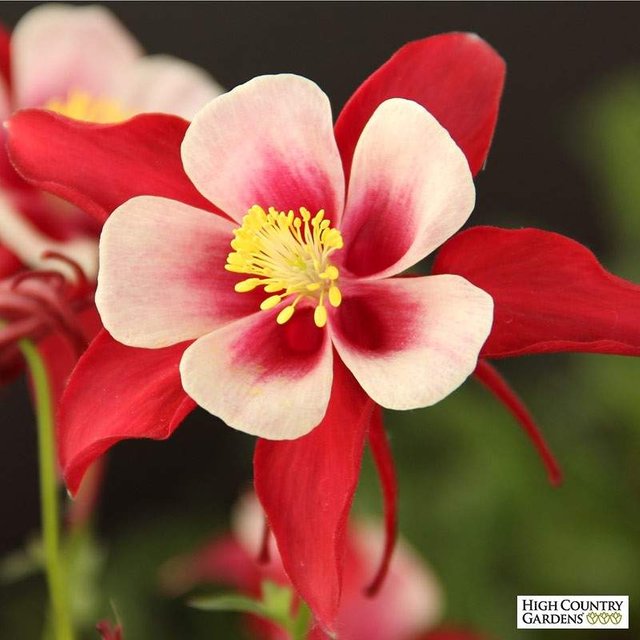

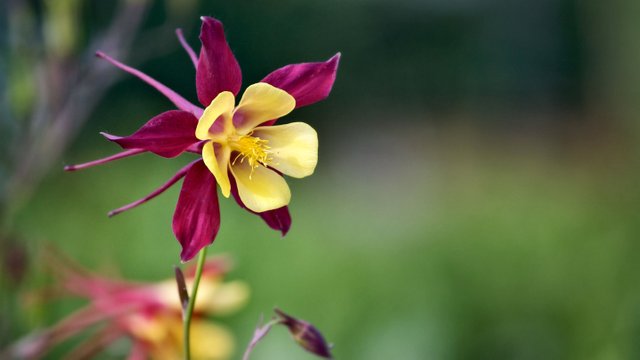
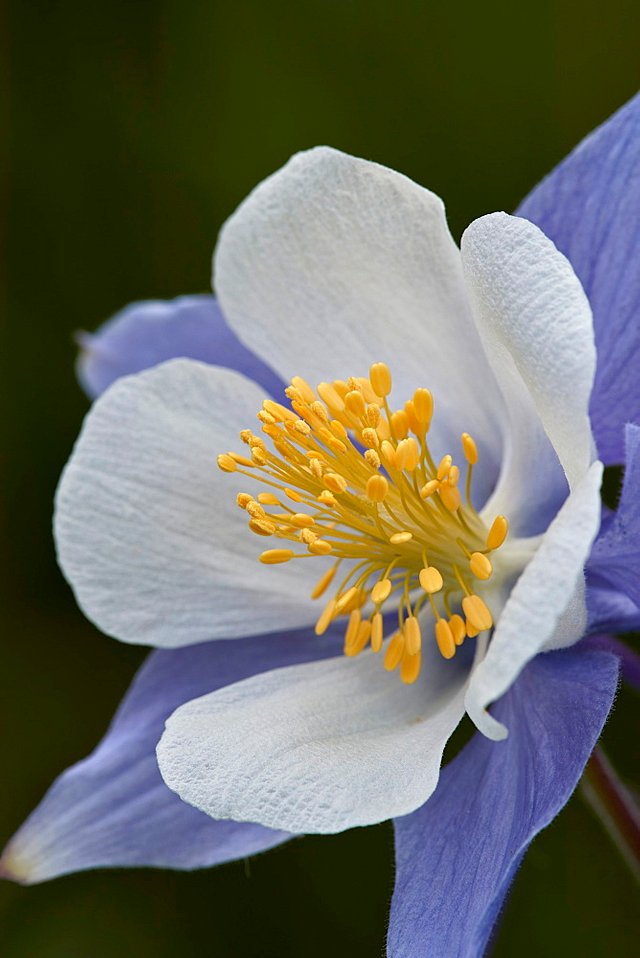
The leaves of this plant are compound and the flowers contain five sepals, five petals and five pistils. The fruit is a follicle which holds many seeds and is formed at the end of the pistils.
Relatives:Columbines are closely related to plants in the genera Actaea (baneberries) and Aconitum (wolfsbanes/monkshoods), which like Aquilegia produce cardiogenic toxins.
Columbines are closely related to plants in the genera Actaea (baneberries) and Aconitum (wolfsbanes/monkshoods), which like Aquilegia produce cardiogenic toxins.
They are used as food plants by some Lepidoptera (butterfly and moth) caterpillars. These are mainly of noctuid moths – noted for feeding on many poisonous plants without harm – such as Cabbage Moth (Mamestra brassicae), Dot Moth (Melanchra persicariae) and Mouse Moth (Amphipyra tragopoginis). The Engrailed (Ectropis crepuscularia), a geometer moth, also uses columbine as a larval foodplant.
Columbine is a hardy perennial, which propagates by seed. It will grow to a height of 15 to 20 inches. It will grow in full sun; however, it prefers growing in partial shade and well drained soil, and is able to tolerate average soils and dry soil conditions.
info-https://en.wikipedia.org/wiki/Aquilegia.
magoo-2 found a series of multi accounts of a same owner is following your articles to cheat your generous rewards.
magoo-2 found these accounts are suspicious & can be multi accounts of a single owner. Conclusion is based on last 30 days transactions:
@rupok
@sarahmcdowell2
@razu788
@tangera
magoo-2
Check our latest multi comment spam update report
Aquilegia Music Series
columbine Music Series
Other common names
columbine Music Series
Family
Ranunculaceae
Genus
Aquilegia are clump-forming herbaceous perennials with long-stalked, ternately divided basal leaves and erect, leafy stems bearing bell-shaped flowers with spreading, coloured sepals and petals with spurs, on branched stems
Details
Music Series is a compact short-lived perennial to 45cm, with long-spurred flowers in shades of red, yellow, blue or white, often bicolored.
https://www.rhs.org.uk/Plants/71392/Aquilegia-Music-Series/Details
Aquilegias
